Hanfu Elements in”Guo Se Fang Hua” (国色芳华): The Revival of Ancient Clothing Beauty

The TV drama “Guo Se Fang Hua” (国色芳华): is a historical drama produced by Huace Film and Television, adapted from the novel of the same name by author Yi Qianchong. It tells the story of He Wei Fang, the daughter of a merchant, who, with the help of Jiang Changyang, starts from cultivating peonies and ultimately realizes her ideal of benefiting the world and serving the country, set against the backdrop of the Tang Dynasty.
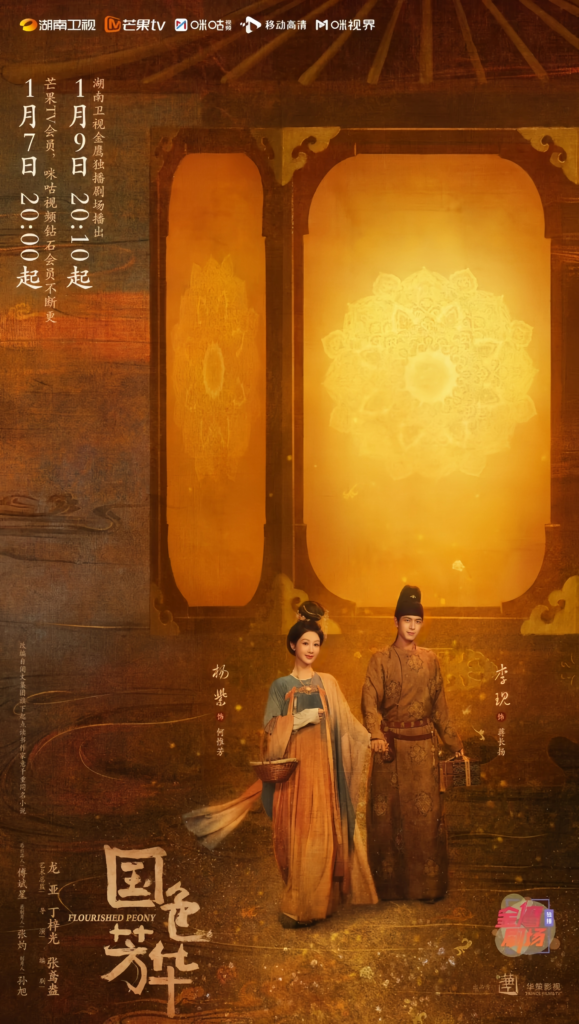
The drama attracts a large audience with its rich historical and cultural background and delicate emotional expressions. Among them, the costume design, especially the clever integration of Hanfu elements, not only showcases the unique charm of traditional Chinese clothing but also presents the audience with a dual feast of both visual and cultural experiences.
From luxurious palace attire to simple civilian outfits, the costume design in “Guo Se Fang Hua” (国色芳华): incorporates many Hanfu elements, making the costumes both full of classical beauty and steeped in deep cultural heritage. Here, we will delve into the Hanfu elements in the drama and appreciate the unique charm of ancient clothing.
Qi Xiong Skirt (齐胸襦裙): Elegance in Layers
The Qi Xiong skirt (齐胸襦裙) steals the spotlight in Guo Se Fang Hua (国色芳华), embodying Tang Dynasty women’s grace. Its high-waisted design, cinched above the chest, elongates the silhouette, pairing a narrow-sleeved shirt with a flowing skirt and cloak. Lapel shirts, sometimes crossed or shallow-collared, peek subtly above the skirt, creating a layered look. Variations like parallel lapels forming a V-shape or deeper Z-shaped overlaps add versatility. Seen in murals like the “Palace Maid” from Princess Li Xianhui’s tomb, this Tang Dynasty clothing style is a bestseller for its timeless appeal. Add one to your wardrobe for instant nobility!

The Qi Xiong skirt usually consists of three parts: a shirt, a skirt, and a cloak, reflecting a unique sense of layering. The Tang Dynasty’s Qi Xiong skirt raised the waistline above the chest, creating a high-waisted design that elongates the body proportions and creates an elegant silhouette. The top is usually a thin, lapel-style shirt with narrow sleeves. Since the skirt covers the shirt, only a small part of the shirt is visible, usually considered to be a lapel-style shirt, but there are also shirts with crossed collars or shallow collar designs. Paired with the high-waisted skirt and long skirt combination, this showcases the elegance and nobility of Tang Dynasty women’s clothing.
The design of the lapel-style short shirt is usually divided into two types: the two lapels parallel to each other and the two lapels meeting in the middle.
When worn, the lapels of the parallel lapel shirt form a V shape, created by the “crossed” wearing method, where the left and right sides overlap.
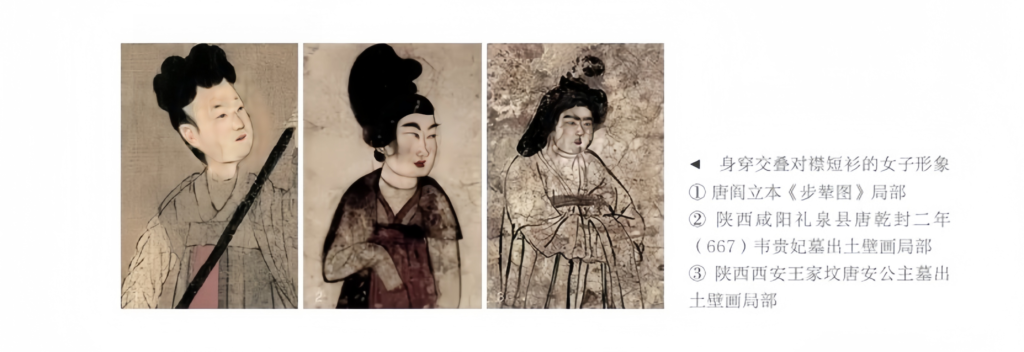
The two-lapel shirt, where the lapels meet in the middle, presents a more streamlined and simplified visual effect. The shallowly overlapped collar of the shallow collar shirt lies between the crossed collar and lapel styles, with the inner and outer collars overlapping and crossing each other for structural support.
This style is quite versatile in its wear and layering, both suitable for being tucked into the skirt as a lapel shirt or worn outside the skirt as a crossed collar shirt.
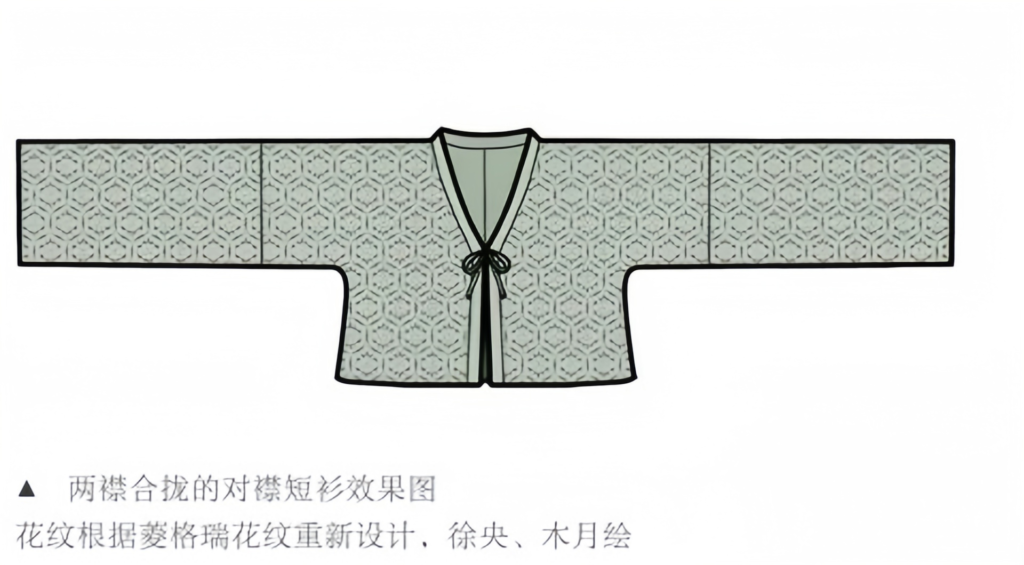
However, there are also deeper overlapping styles where the inner and outer collars tilt, forming a “Z” shape.

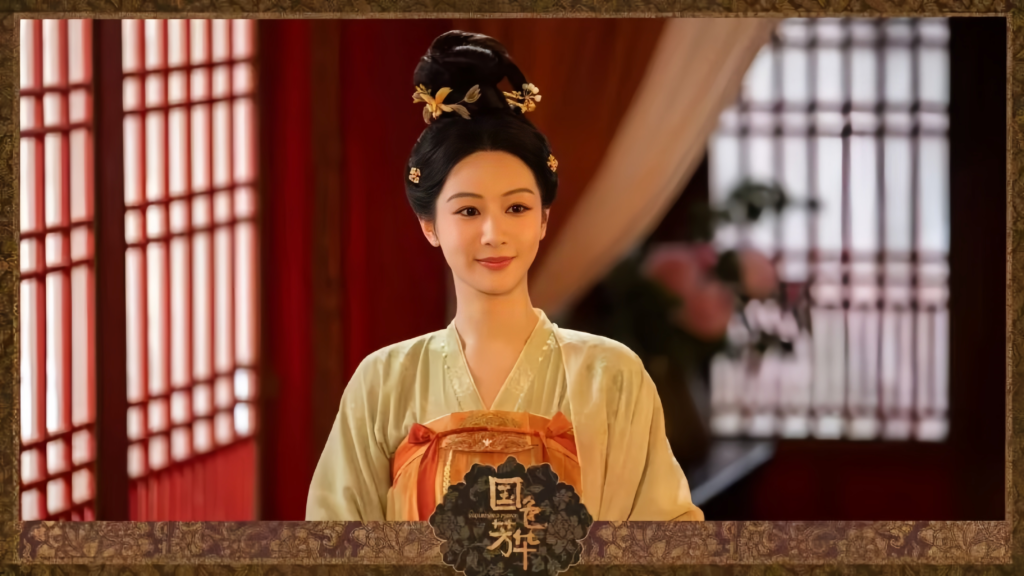
The Qi Xiong skirt is a typical style of Tang Dynasty women’s clothing, characterized by raising the waistline to the armpits. This feature allows women to achieve an excellent head-to-body ratio and is a classic skirt style in Hanfu women’s fashion. The various combinations of styles in the Qi Xiong skirt not only give it a layered look but also bring a delicate sense of history and cultural atmosphere to the audience.

The specific form of this classic skirt can be referred to in the mural “Palace Maid” found on the south side of the eastern wall of the front room of Princess Li Xianhui’s tomb in Qian County, Shaanxi Province. The palace maids are seen with high hairstyles, draped scarves, and clothing primarily composed of a shirt and skirt, with a high-waisted skirt that extends to the floor, demonstrating the typical form of this garment.
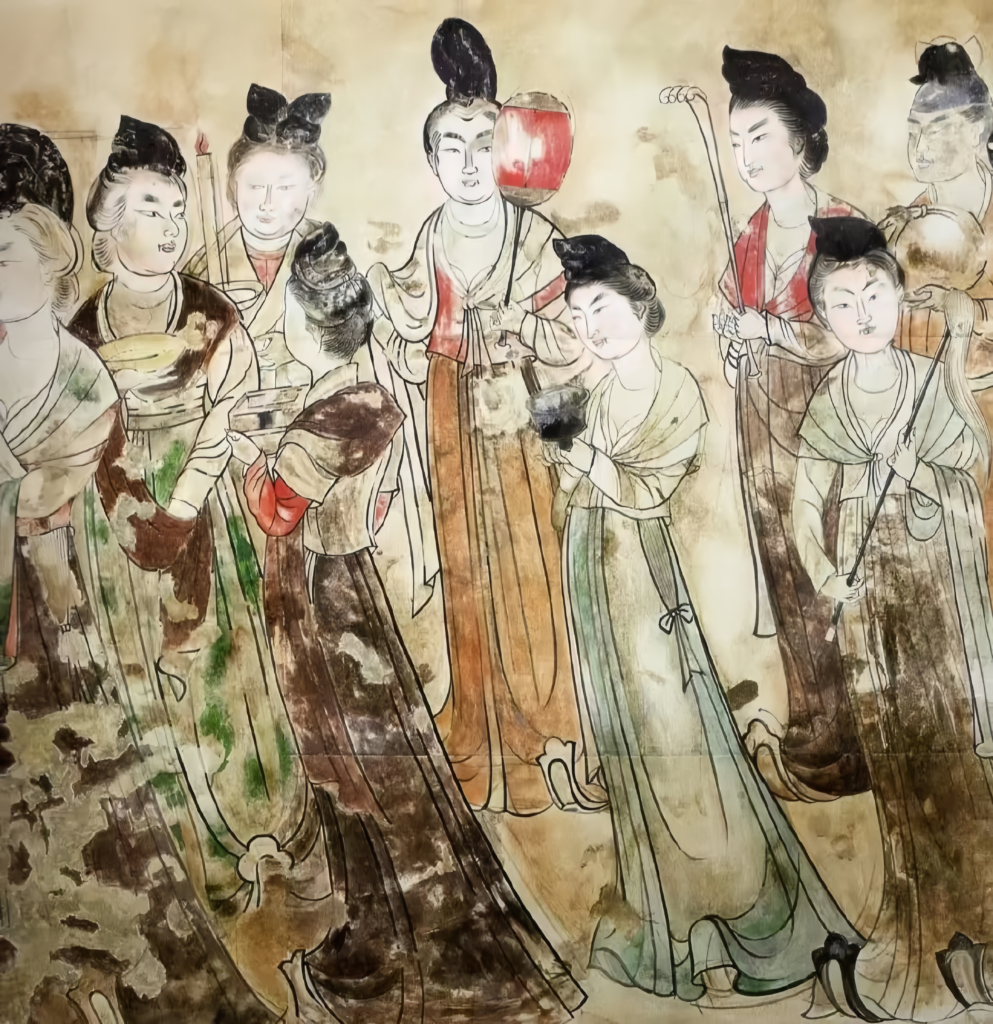
Tang Yongtai Princess Li Xianhui Tomb Mural “Palace Maid Picture
Beizi (褙子): Practical Yet Graceful
Beizi (褙子) brings understated elegance to the drama’s costumes. This sleeveless or short-sleeved outer layer, worn over skirts, is compact and adaptable, ideal for spring or autumn. Its V-shaped collar, blending crossed and lapel styles, offers flexibility—tucked in or flowing free. Unearthed artifacts, like the silk Beizi from Astana, Turpan, show its simple yet refined structure. In Guo Se Fang Hua (国色芳华), Beizi highlights characters’ poise, making it a must-have for buyers seeking versatile Hanfu elements. Pair it with a Qi Xiong skirt for a classic Tang look.
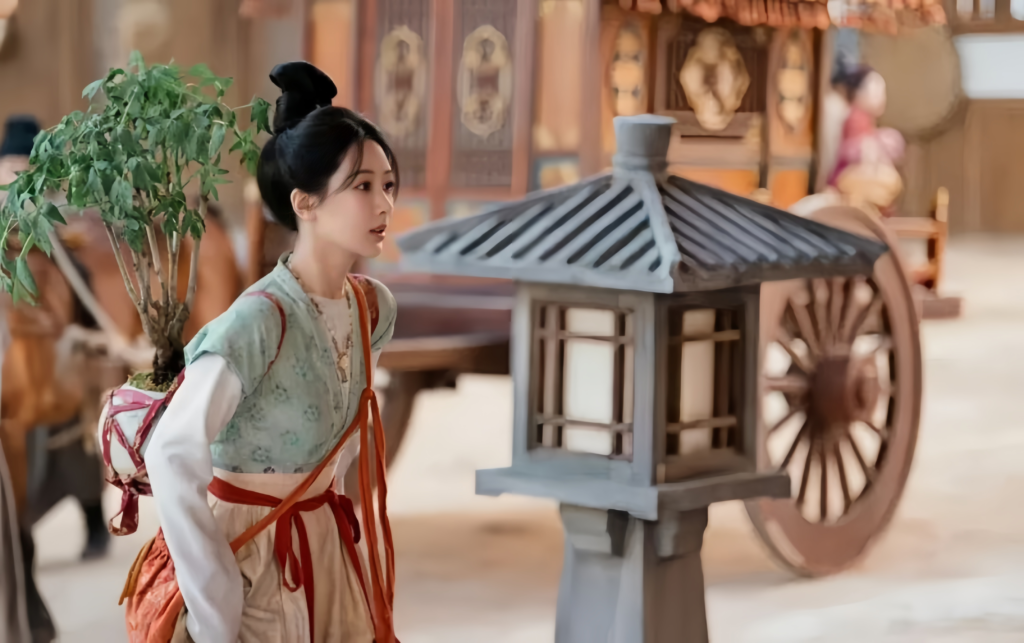
Bei Zi is a highly practical piece of clothing. In simple terms, Bei Zi is a short outer garment worn by women that does not have sleeves or side seams, often tucked into the skirt. The half-sleeves end above the elbow, while the sleeve length of Bei Zi is shorter, almost reaching the shoulder. In terms of wear, Bei Zi is more compact than half-sleeves, making it ideal for wearing in the spring and autumn, offering flexibility to adjust for temperature changes. In the drama, Bei Zi is worn outside the skirt as an outer layer of clothing, providing warmth while highlighting the character’s graceful demeanor.

From a structural standpoint, Bei Zi does not have sleeves, and the sleeve edges meet at the armpits. The inner and outer lapels are slightly overlapped, forming a V-shaped collar, positioned between the crossed collar and lapel styles. The form is highly versatile, with many variations.

A silk robe and painted wooden figurine unearthed in Astana, Turpan, depicts the “Bei Zi” worn by the upper body. Its structure is simple yet exquisite, with variations in the crossed and lapel collar designs that allow the wearer to demonstrate both the ancient feminine grace and a free-spirited, dynamic feel.
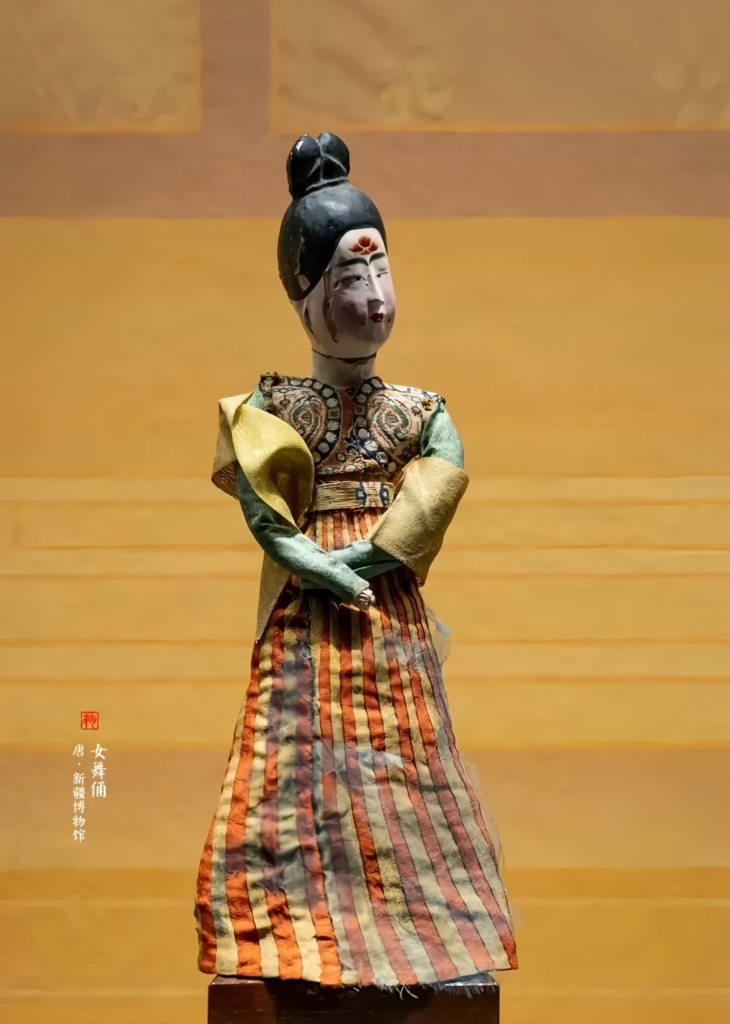
Tang Dynasty Female Dancer Figurine
Round Collar Cross-Collar Robe (圆领交襟袍): Men’s Sophistication
Male characters shine in the round-collar cross-collar robe (圆领交襟袍), a Sui-Tang innovation blending crossed robes with open-necked designs. Available slitted for movement or non-slitted as a “Lan” robe, it suits both casual and formal scenes. Murals like the “Feast” from the Wei family tomb in Xi’an reveal its thick, elegant form. This Tang Dynasty clothing piece, seen in Guo Se Fang Hua (国色芳华), appeals to modern shoppers for its balance of style and function. Stock these robes to capture the growing male Hanfu market!
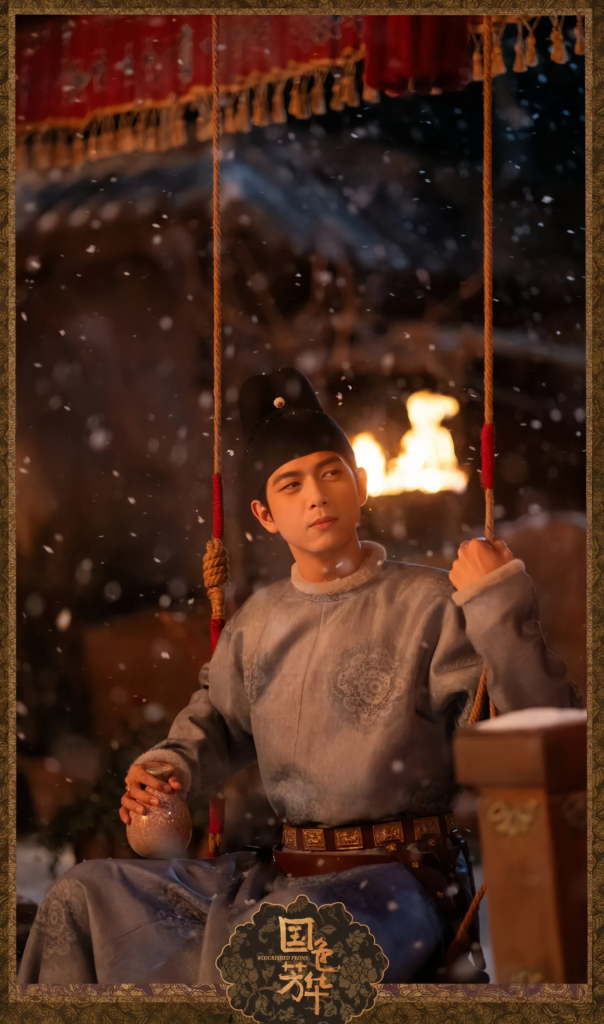
The round-collar crossed robe is a new style created by combining elements from the crossed robes and open-necked garments, absorbing external influences. It was a common basic style during the Sui and Tang Dynasties, with both slitted and non-slitted versions available, making it practical and stylish, suitable for both daily and formal occasions.
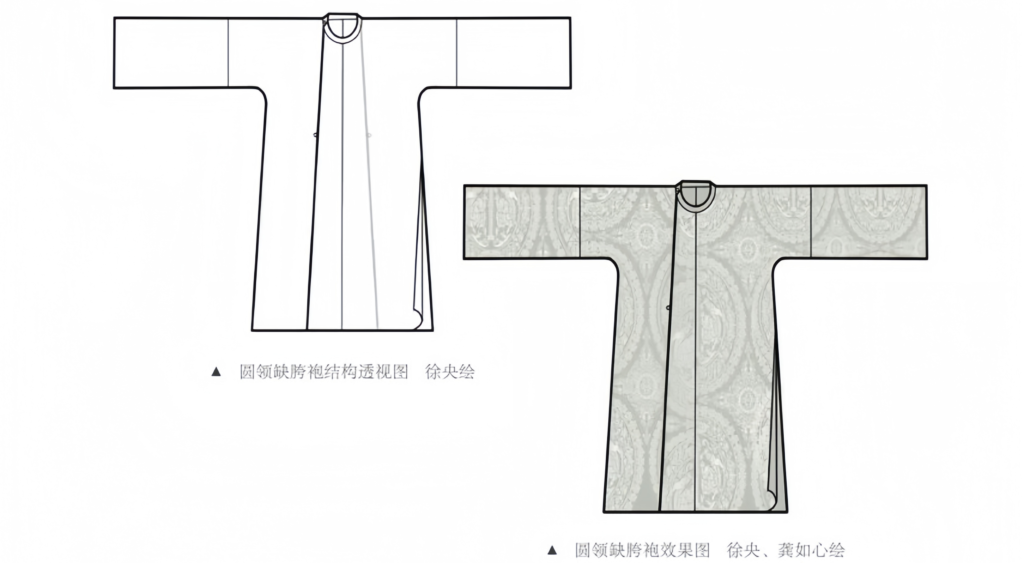
The term “slit” refers to the opening on both sides of the robe. In terms of cutting, the front and back pieces near the lower hem are not sewn together, allowing for greater leg movement and revealing the inner clothing when walking. Depending on the style and occasion, the slit may be high or low, with some even featuring decorative patterns at the slit.
The non-slitted version, known as the “Lan” robe, does not have side slits, and it features a round collar.

In the Tang Dynasty, “robe” generally referred to a thick, long outer garment, while “shirt” referred to thinner single-layer clothing. Thus, the difference between a Lan robe and a Lan shirt mainly lies in the thickness, but the basic structure remains the same.

The specific form of this design can be seen in the mural “Feast” found in the tomb of the Wei family in the south of Weiqu, Xi’an, Shaanxi Province.

Tang Dynasty Wei Family Tomb Mural “Feasting Scene
- Hairstyle Elements
Duo Ma Ji (堕马髻)(Falling Horse Hairpin)
The Falling Horse Bun is a common hairstyle for women in the Tang Dynasty, with a unique form resembling the posture of someone falling off a horse. The bun is tilted to one side, with one part hanging down. The hairstyle is dynamic and carries an air of nobility.
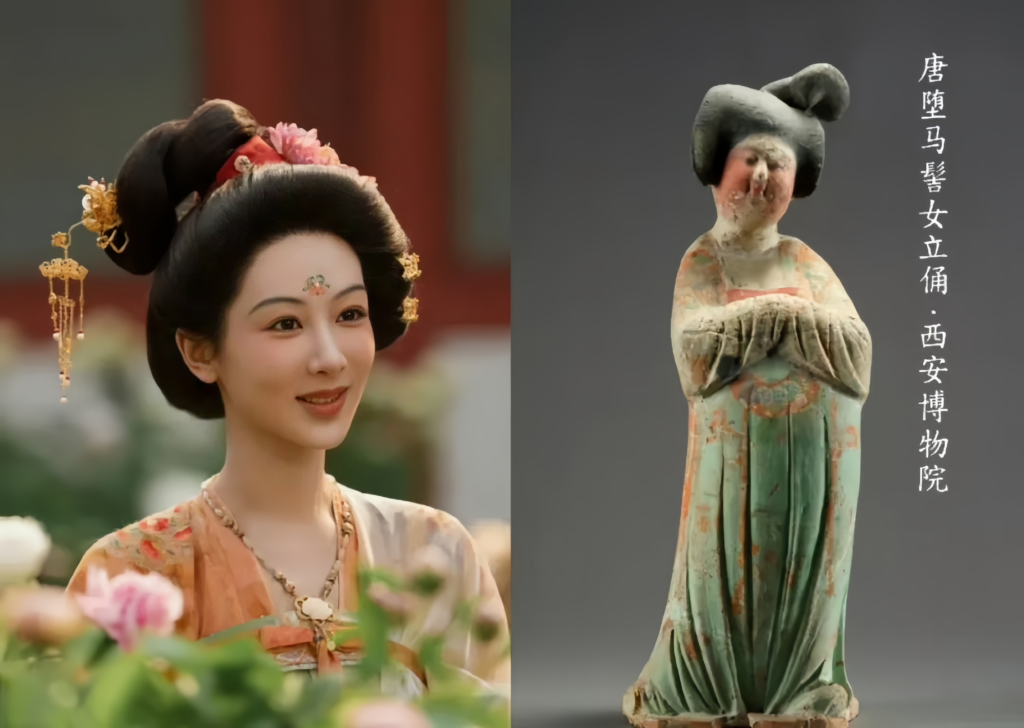
Right Image: Tang Dynasty “Fall from Horse” Hair Knot Female Standing Figurine
The Falling Horse Bun is a symbol of the Tang Dynasty aristocracy, reflecting the pursuit of refined hairstyles in the upper classes. Several female characters in the drama adopt this hairstyle, enhancing the characters’ nobility and elegance. Reference can be made to the Tang Dynasty standing female figurine with the Falling Horse Bun in the Xi’an Museum.
Single-Dagger Half-Flip Bun(单刀半翻髻)
The Single-Dagger Half-Flip Bun is a tall hairstyle, popular among women in the Tang Dynasty. It is a type of knife bun, also known as the Single Knife Bun. This hairstyle is frequently seen in the various terra-cotta figurines and murals from that period, representing aristocratic women.
The bun is tall and curved to one side at a specific angle, with the top slightly bent downwards, resembling a large knife. This is the origin of its name. A reference can be made to the Tang Dynasty painted clay figurine of a noblewoman with this hairstyle in the Lushun Museum.
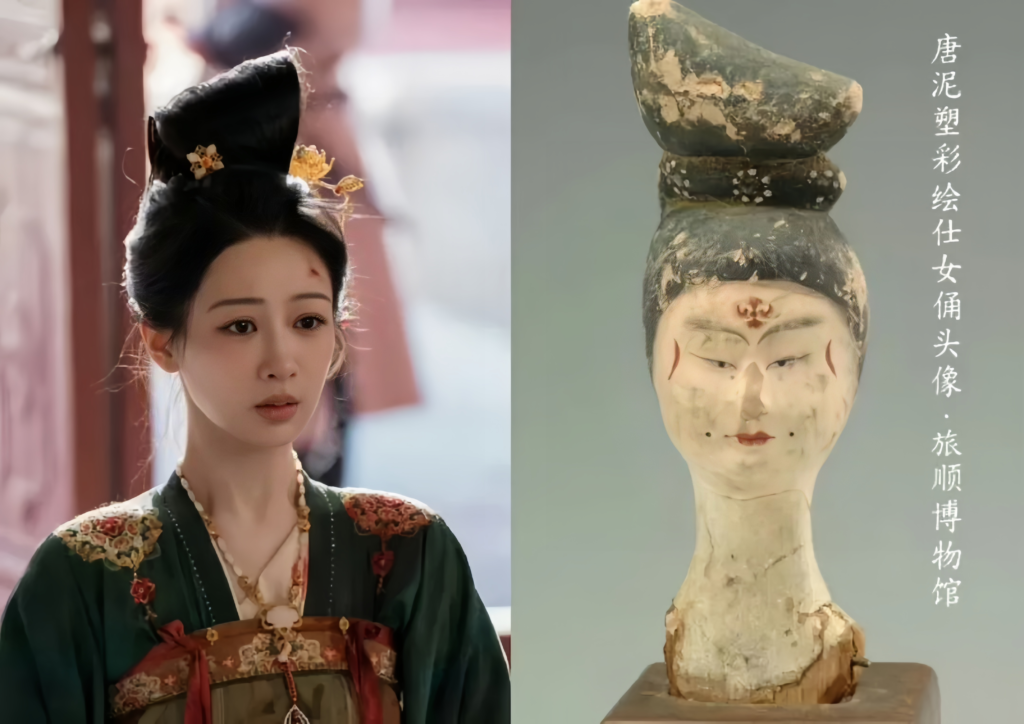
Right Image: Tang Dynasty Clay Painted Lady Figurine Head
Crossed Heart Bun(交心髻)
The Crossed Heart Bun is a daily hairstyle for Tang Dynasty women, characterized by two crossed buns. The design is not only aesthetically traditional but also slightly playful.
The Crossed Heart Bun’s inspiration comes from the single or double small buns of the Gaozong period, with two buns crossed to create a unique beauty. Reference can be made to the Tang Dynasty painted clay figurine of a woman holding a waist drum in the Palace Museum, Beijing.
The characters in the drama with Crossed Heart Buns reflect the typical daily hairstyle of the Tang Dynasty while also adding a unique cultural touch.

Right Image: Tang Dynasty Ceramic Painted Female Figurine Holding Waist Drum
Double Drop Bun(双垂髻)
The Double Drop Bun is a common hairstyle for unmarried women or palace maids in the Tang Dynasty, especially popular among unmarried women or palace maids. The hair is divided into two parts, with the temples neatly combed upwards, and the buns are formed on top of the head. The buns are either full and round or small and pointed, known as the “double buns.” This hairstyle adds a youthful and playful touch to the character, aligning with the historical context. A reference can be made to the Tang Dynasty standing female figurine with Double Drop Bun in the Xi’an Museum.
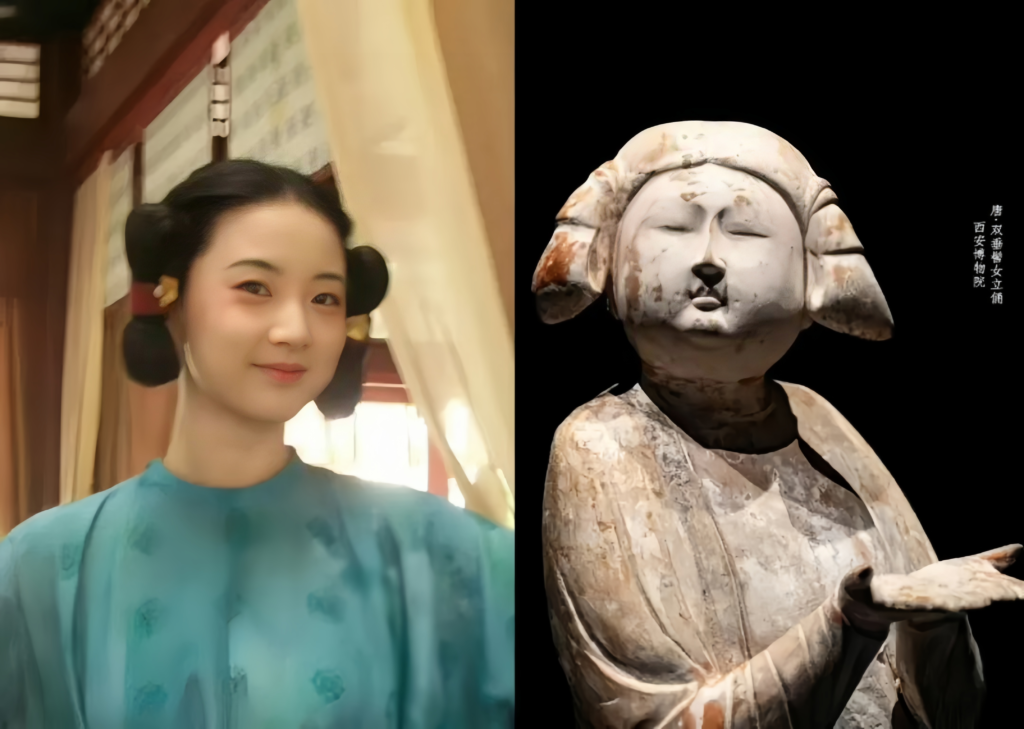
Right Image: Tang Dynasty Double-Hanging Hair Knot Female Standing Figurine
Makeup and Accessories: Cultural Symbols
The drama’s makeup and accessories deepen its Hanfu appeal. Wine-Blush Makeup (酒晕妆), with its flushed rouge, evokes Wu Zetian’s era, as seen in Turpan figurines. Li Youzhen’s wedding crown, inspired by Li Cui’s jeweled masterpiece in the Shaanxi Archaeological Museum, dazzles with silk and gems. Men’s Fu Tou (幞头) headscarves, evolving from silk to lacquered gauze, signal status. These details make Guo Se Fang Hua (国色芳华) a treasure trove of Tang Dynasty clothing inspiration. Explore more at The Metropolitan Museum or this scholarly article.
Fu Tou (幞头)(Headscarf)
Fu Tou is a headwear for Tang Dynasty men, typically a soft scarf wrapped around the head, which is both practical and signifies the wearer’s social status.
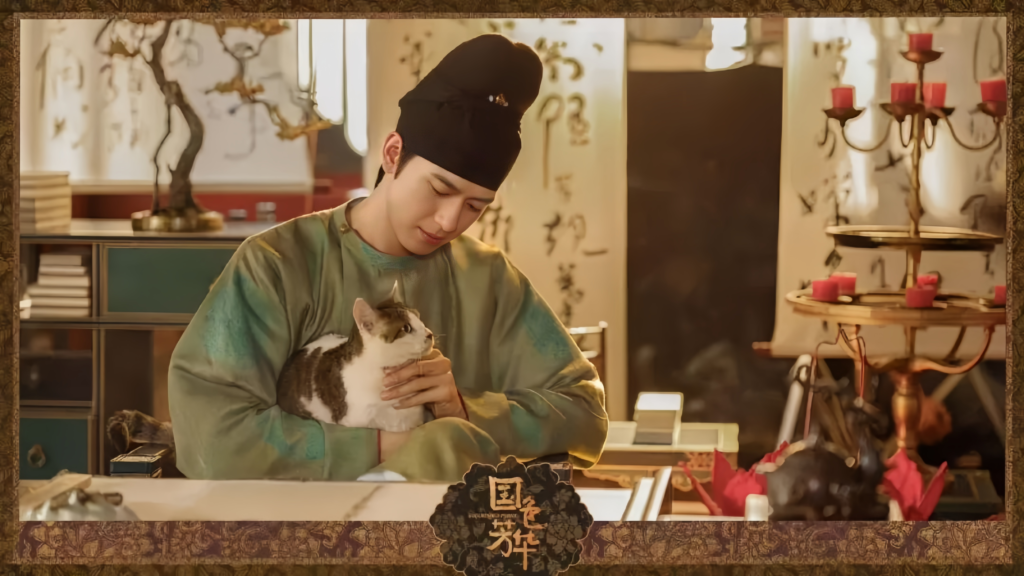
The evolution of Fu Tou went from the soft-foot Fu Tou at the beginning of the Tang Dynasty to the long-foot Luo Fu Tou in later periods, reflecting the fashion changes in male clothing during the Tang Dynasty.
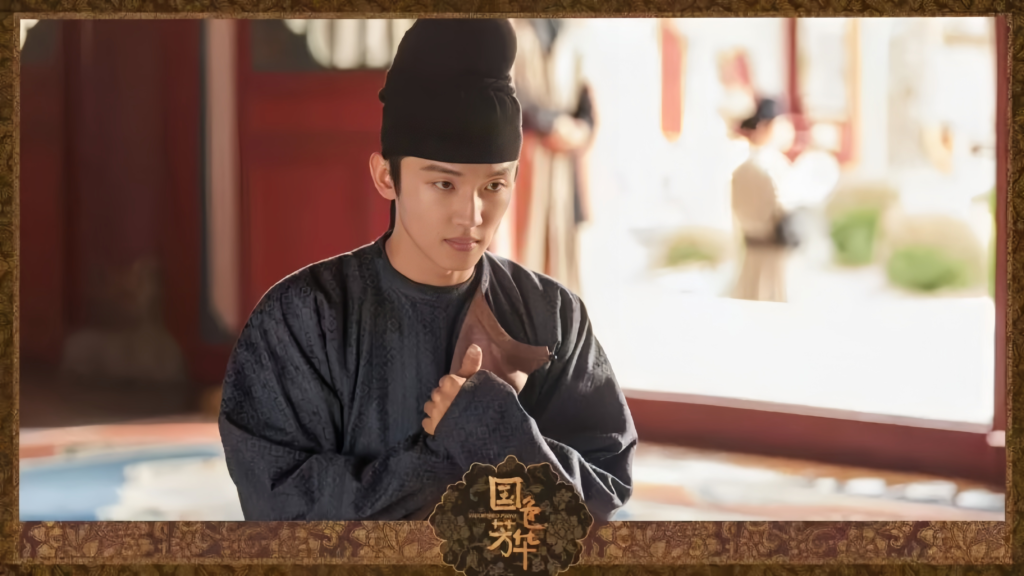
The material of Fu Tou also evolved from fine silk to lacquered gauze, showcasing the exquisite craftsmanship of ancient times.
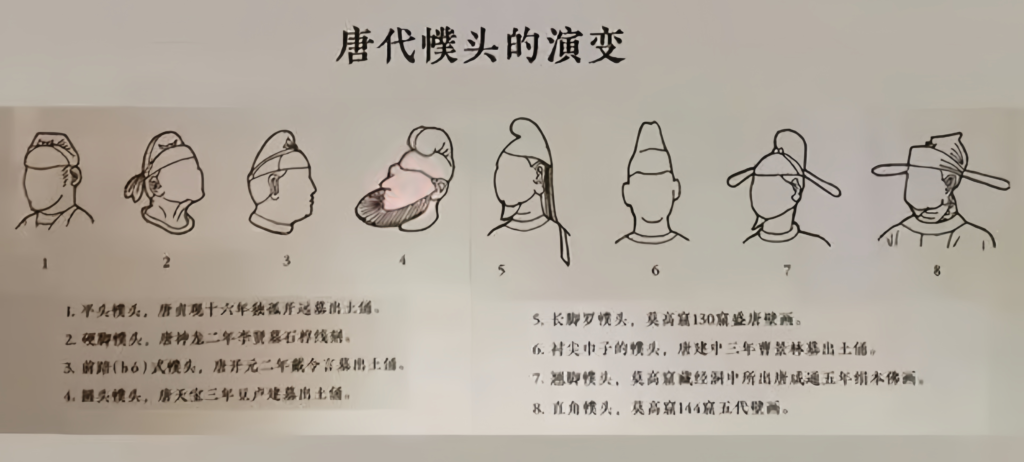
Tang Dynasty Futou Evolution Diagram
Crown Accessories
The Crown Accessories by Li Youzhen at her wedding in the drama is inspired by the wedding crown of Li Cui from the Tang Dynasty. Li Cui’s wedding crown is considered one of the finest in Tang Dynasty female crown accessories, made with silk and adorned with jewels, presenting an extraordinarily luxurious effect. This crown is not just a decorative item but also symbolizes a woman’s identity and status.

The crown of Li Cui is currently housed in the Shaanxi Archaeological Museum. It is the only reconstructed Tang Dynasty female crown and encompasses nearly all the materials and craftsmanship of the Tang Dynasty.
The main body of the crown is wrapped in silk, with jewel decorations covering the bun. The wing-shaped accessories are positioned in the front, with jeweled hairpins inserted on either side of the crown.

Wine-Blush Makeup(酒晕妆)
The “Wine Blush Makeup” is a unique makeup style for Tang Dynasty women, popular during the reign of Wu Zetian and the flourishing Tang period. It features a base of white powder, with flower ornaments, red rouge, and facial embellishments, applying heavy rouge to the face, eyes, and ears, giving the appearance of a drunk flush. Reference can be made to the Tang Dynasty female dancer figurine found in Astana, Turpan, Xinjiang, tomb 206.
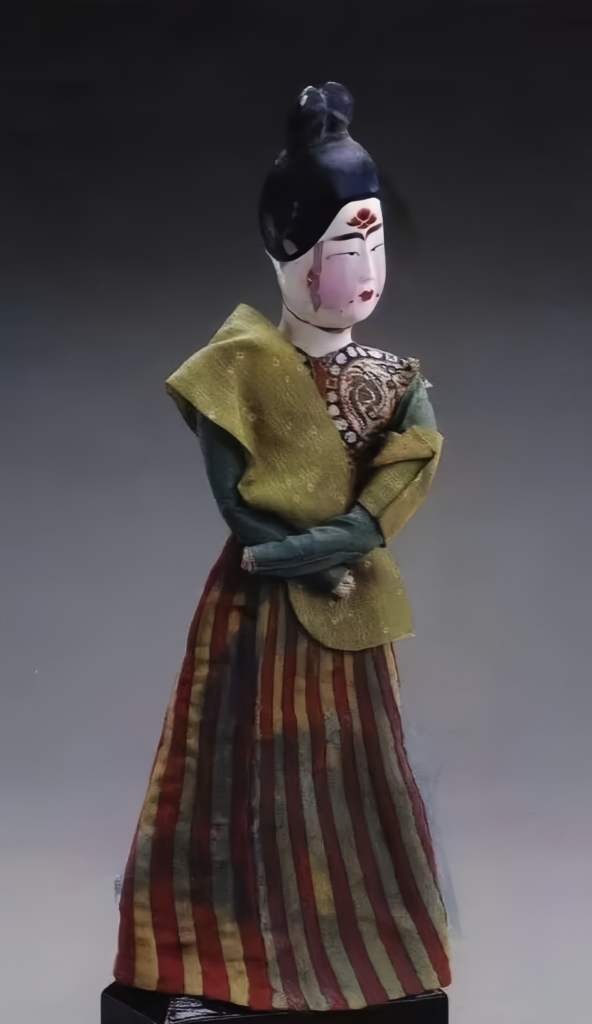
Tang Dynasty Female Dancer Figurine
In the drama, the wedding makeup of Li Youzhen and the appearance of Princess Huangfu Lingge both showcase this distinctive makeup style.

Embrace Hanfu’s Revival
Hanfu elements in Guo Se Fang Hua (国色芳华) blend beauty and heritage, from Qi Xiong skirts to intricate buns. These five features—skirts, Beizi, robes, hairstyles, and accessories—showcase Tang Dynasty clothing’s enduring allure. As a Hanfu fan or shopper, let the drama inspire your style with pieces that tell a story. Visit our store to explore authentic Hanfu designs and bring Guo Se Fang Hua (国色芳华) to life! Shop now and celebrate Hanfu culture in 2025.

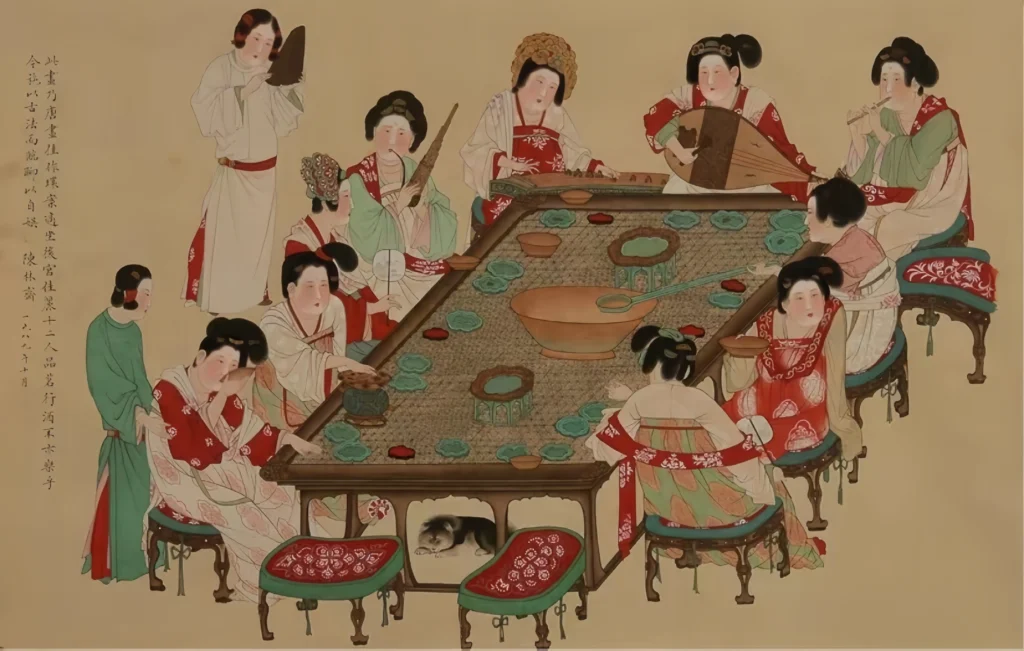
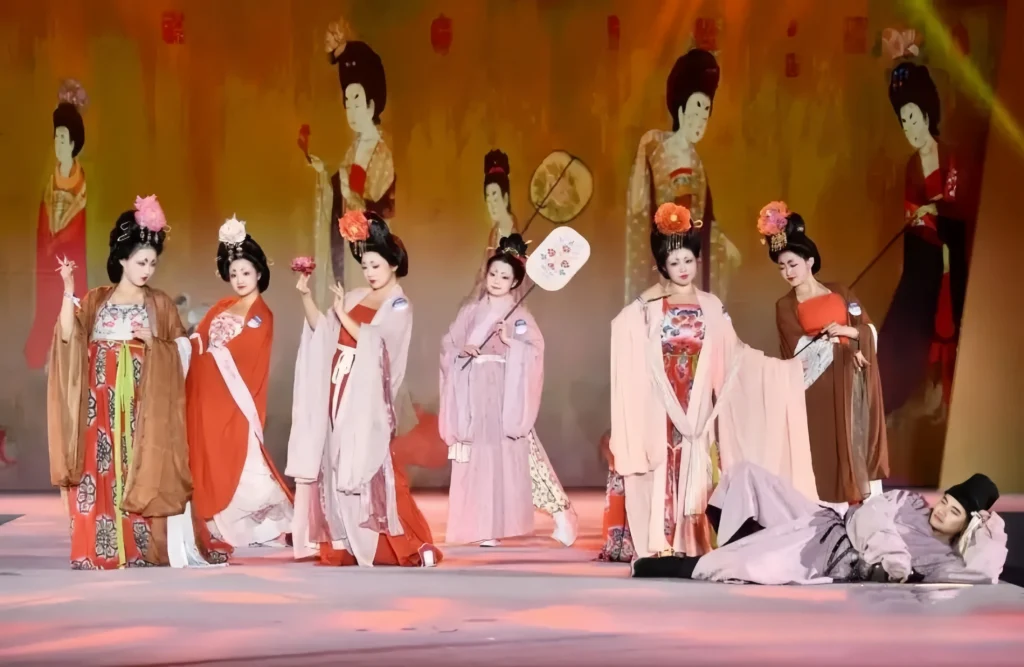


Responses